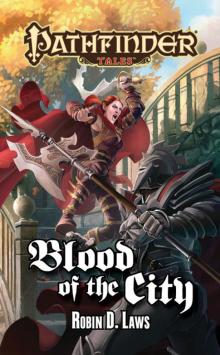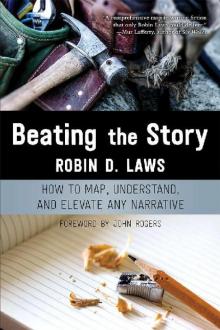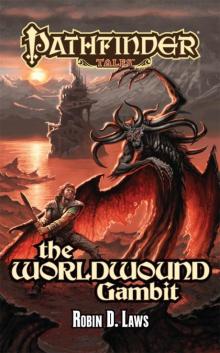- Home
- Robin D. Laws
Beating the Story Page 7
Beating the Story Read online
Page 7
Although events arising from the core question contribute more to your narrative than free-floating Bringdowns, they don’t register as authorial cheating the way an excess of Gratification beats would.
Focus Characters
Although we are used to thinking of narratives as having either a sole protagonist or very limited number of key characters, scenes can fluidly and radically shift perspectives. Viewers may react to these shifts instinctively without even noting it.
For example, James Bond appears in almost every scene of the first 007 film, Dr. No. But in one quietly remarkable scene, a secondary villain, Professor Dent, is summoned to appear before the disembodied voice of the as-yet-unrevealed titular villain. The scene makes us fear for Bond by establishing his main antagonist as formidable. It does so by putting us in Professor Dent’s shoes. He fears the man behind the voice, so we do too. Although ultimately we fear for Bond, for this one scene Dent has become the character through whom the vicarious emotion is focused—hence the term focus character.
On a similar note, many crime and horror TV shows start with a cold open in which a character previously unknown to the viewer introduces the episode’s main threat, usually by getting murdered. We feel the fear and menace through that character or characters, making them the focus characters for that one scene only. As in the Professor Dent example, the fear we felt for them then transfers to our traditional protagonist, who we either fear will also fall prey to the threat, or alternately, will fail to solve the case.
Through vivid portrayal, you may be able to foster empathy for a character who fleetingly takes focus. This works best in the voyeuristic medium of film, where acting and camera placement can make us suddenly relate to the world through sometimes-unwelcome perspectives. Moments after Janet Leigh’s character, Marion Crane, is murdered in Psycho, we abruptly shift sympathy to Norman Bates—not in spite of the fact that he’s engaged in the guilty activity of cleaning up the scene, but because of it.
(Psycho operates as a fascinating case study in bending the rules of identification, even throwing its first core question out the window when Marion dies. As you’ll see if you break it down using the beat analysis system, it gains its unnerving power by repeatedly breaking a movie’s implicit contract with its audience. Psycho bristles with exceptions that test the rules laid out in this book.)
For greatest impact, though, you’ll want to ensure that the character’s actions relate to the core question in a way that readers find evident. This allows them, by implication, to hope or fear for one or more of your protagonists.
From Procedural to Dramatic, and Vice Versa
If your story uses both Procedural and Dramatic beats, you can achieve rhythmic variety, not to mention a sense of unity and coherence, by varying their appearance in your narrative sequence.
A Dramatic beat or scene might arise from a Procedural one when:
a character suffers a procedural setback and must then deal with the emotional fallout
or a character achieves a procedural victory and then seeks an emotional reward
A Procedural beat might arise from an emotional one when a character must perform an external task after promising to do so:
when granting a petition made by another character
or when petitioning another character for an emotional reward
Turning Commentary Beats Into Foundation Beats
Commentary beats shift a work of fiction from the emotional to the rhetorical. Even the flattest scene of basic plot development in an unambitious genre outing can maintain reader engagement by invoking our hopes and fears. When your goals switch to that of the essayist, you’re calling on the intellect, and can expect to lose attention quickly if the content of that essay fails to utterly compel from one moment to the next.
This is not to say that narrative should not seek to convey meaning or establish a thesis. But if you can make the action symbolic of your thematic intent, the result becomes both more compelling and more likely to persuade than if you have a character simply declaim your view.
In fiction, having a character explaining the cost of, say, climate change is much less effective than showing a character struggling with that cost.
Transition Mapping
Ensure strong pacing for your story by mapping the scene transitions that maintain and build its momentum.
Momentum
Along with the ups and downs of fear and hope, momentum serves as a key determining factor in engaging your viewers.
In prose forms, momentum keeps your reader from putting your book down, even when really she needs to get to bed because she has a big day at work ahead of her but man, if she just reads one more chapter she’ll find out if Claire gets to the rendezvous with Jamie in time and oh no okay one more chapter after that and…
In dramatic forms, momentum keeps viewers on the edge of their seats, stoking excitement and preventing minds from wandering to the various distractions of the day. It is the secret weapon of well-reviewed, well-attended crowd-pleasers and blockbusters.
Your main tool for strong momentum is the scene transition.
Scenes and Blocks
Before discussing the connective tissue between scenes, let’s clarify our particular use of the term “scene.”
For beat analysis purposes, a scene consists of all action occurring together in one time and/or place.
In this definition, a scene might encompass one beat, several beats, or many beats.
In the theater, a long string of dramatic exchanges between different sets of characters may occur on a single set before a blackout indicating a shift in time, or in which a set change occurs. In modern film and television, scenes can consist of a single beat.
(The concept of “place” can require stretching when a sequence features characters interacting or cooperating while physically separated. When characters in different cities have an argument over the phone, it’s still the same scene even if one is in a hotel in Milan and the other is walking along Fifth Avenue in New York. Likewise, you might be cutting between your cast of heist caper characters as they all perform their parts in the casino break-in. Both cases still portray one continuous action; the shifts between one character speaking and the other, or the cutaways between characters, are micro-shifts that already thread together and maintain their own internal momentum. As you map transitions, if you ever find yourself wondering, “Do I really need to count this one?,” you don’t have to count that one.)
Transition Types
Citizen Kane, for all the intricacies of its unreliable narrators, framing device, and fractured chronology, keeps the viewer hooked through its artful use of transitions. Your story might not require quite that much attention to momentum, but considering the power of your transitions can never hurt.
The beat analysis system identifies nine kinds of scene transition:
Outgrowth
After a shift in time, place, or both, the narrative develops from a consequence of the immediately previous scene.
Previous scene: In the break room, Jesse convinces Mustafa to tell him the truth—Katya is trying to squeeze him out of the company.
Following scene: Jesse bursts into Katya’s office to confront her.
Previous scene: The team scales the walls of the castle.
Following scene: The team battles guards on the castle parapet.
Previous scene: Victor recaptures the monster out in the woods.
Following scene: Back in the castle, Victor enters the chamber where he has chained up the monster.
Previous scene: At his apartment, Jing rejects Sunya’s plea to get his drinking under control.
Following scene: In a cafe the next day, Yueming tries to console Sunya without saying, “I told you so.”
Because it continues an overtly obvious story thread from one scene
to the next, the Outgrowth transition builds strong momentum. The first scene sets up a question: “What will Jesse do with the news?” “Will they get all the way into the castle?” “What will Victor do with the monster now?” “What can Sunya do now?”
The shift launches the audience immediately into a scene that promises to answer that question.
Continuation
A Continuation marks the transition between two scenes featuring the same focus character in pursuit of the same goal, even though the action of the second does not directly result from a new situation established in the first. Unlike an Outgrowth, each scene makes sense on its own. The new scene would still make sense if you cut the previous one.
Scenes at the beginning of a piece establishing a character’s life routines or status quo often connect through a string of Continuations.
Because you’re placing two scenes with the same elements (character and goal) next to one another, you’ll typically want to vary something else between them, such as additional characters, setting, or outcome.
Previous scene: Alone in the new city, Yumiko goes to the zoo, where even the animals shun her.
Following scene: Yumiko, still lonely, tries to strike up a conversation in a cafe.
Previous scene: The morning after a late night of partying, Poppy says a cheerful goodbye to her more exhausted friend, demonstrating her irrepressible energy and spirit.
Following scene: Poppy excitedly gathers up materials for a craft project.
Previous scene: Restless and isolated, Travis seeks direction and guidance from a respected fellow cabbie.
Following scene: Still looking for something to connect to, Travis eats the sad breakfast of an isolated loner as he watches a presidential candidate interviewed on television.
Sometimes a shared goal between scenes is enough to function as a Continuation, even when pursued by separate characters working in parallel.
Previous scene: Roger secures the explosives.
Following scene: Antti hacks into the corporation’s security system.
Turn
A Turn connects two beats featuring the same viewpoint character, pursuing clearly different goals.
After the Outgrowth and the Continuation, the Turn is the third smoothest beat transition. We remain invested with the same protagonist, but must adjust to a situation entirely different than the one we were just engaged with.
Previous scene: Nils cleans up the wreckage at the video store.
Following scene: Nils meets his in-laws for a tense dinner.
Previous scene: Anya finally convinces Daniela to train her in polearm fighting.
Following scene: Anya goes for an early morning swim, not noticing the crocodile hidden on the shore.
Previous scene: Don watches as Bert convinces Roger to join the effort to free the firm from the impending buyout.
Following scene: Betty tells Don she wants a divorce.
Break
A Break transitions not only to another time and/or place, but either introduces or picks up an entirely different plot thread.
Previous scene: Dre collapses in exhaustion, as his obsessive devotion to his training regimen takes its toll.
Following scene: Williamson intimidates a rival into ceding his territory.
Previous scene: Marta sells the shareholders on the virtues of her new security software.
Following scene: Reg falls asleep at the wheel of his pickup truck and crashes into a stop sign.
Previous scene: Hera rebuffs Zeus’ clumsy advances.
Following scene: Hephaestus completes a new sword, one so powerful it frightens even him.
Previous scene: Carmen tells Annabelle to stop calling her.
Following scene: A week later, Carmen hears a mysterious scratching noise coming from the walls.
A Break transition costs you momentum, as you have to reestablish the viewer’s attention with the new set of circumstances and the hopes and fears that flow from that. This loss of momentum lessens if you’ve laid the groundwork for the audience to anticipate the resumption of this other plot thread.
Viewpoint
A Viewpoint transition occurs when you shift to a scene that presents someone as a focus or viewpoint character for the first time. This needn’t mark the first appearance of a character, but it is the first time readers experience a scene from the character’s point of view. This may refer to the literal point of view of first person narration. More often it means that our emotional perspective aligns with that of the character; we fear that the scene will end badly for her and hope that it will end well.
This special transition beat notes the extra cognitive cost of identifying with a new character and forgetting for the moment the character we were already invested in.
Subsequent shifts back to this character’s perspective are marked with other transitions—often Breaks, Meanwhiles, or Rhymes.
Previous scene: Martha, our protagonist so far, enters a dark hallway.
Following scene: A new character, Jordan, emerges sleepily from a laundromat, carrying a basket of damp clothes.
Previous scene: Dr. Ozon swears eternal vengeance on the living.
Following scene: Reporter Camille Ferron, who we have seen before but has never taken the lead in a scene, approaches her editor with a zealous look in her eyes.
Rhyme
A Rhyme takes a Break transition and smooths it over with a visual or thematic element that appears at the end of the outgoing scene and reappears, changed somewhat, at the top of the incoming scene. This link creates a harmony that would otherwise not exist, but does call attention to itself.
Previous scene: A hominid throws a bone into the air.
Following scene: A spaceship, vaguely recalling the shape of the bone, travels through space.
Previous scene: A close-up of an eye.
Following scene: A close-up of a planet.
Previous scene: Camera pans up to a taxidermic deer’s head trophy hanging over the mantle.
Following scene: A live deer nibbles at the underbrush in a lush forest.
Although particularly suited to visual media, you can also rhyme, albeit more subtly, in prose scene transitions. For example:
Joe poured himself another shot. “Cops know better than to mess with me.”
***
Officer Janice Stokes let her squad car cruise to a stop on a gravel shoulder out by I-98. Damn caffeine headache. She’d given up coffee because it made her crave cigarettes, and those she definitely had to quit.
Meanwhile
A Meanwhile transition shifts place but either happens simultaneously with, or immediately after, the previous scene. Its action does not occur as a consequence of the previous scene—otherwise it would qualify as an Outgrowth. Still, the connection in time indicates to the reader a stronger relationship than a Break, implying an eventual coming-together. Typically you’ll also want an implied connection between the two scenes, which might simply be an already established interrelationship between the two characters or situations. One scene might not stem from the other, but the audience can see that they will soon converge.
Meanwhile transitions suggest an attention to plotting and suspense that may not be relevant for a purely character-driven or mood piece.
Previous scene: Jesse confronts Katya over her attempt to squeeze him out.
Following scene: Meanwhile, a man steals the laptop we previously saw Katya leave in her car.
Previous scene: The team battles guards on the castle parapet.
Following scene: Elsewhere in the castle, unaware of the fighting above, King Friedrich elects to torment the captive prince.
Previous scene: Victor enters the chamber where he has chained up the monster.
Followin
g scene: In the town square, villagers gather to scold the burgomaster returning custody of the creature to Victor, who they distrust.
The strength of this transition in maintaining momentum depends on the viewer’s ability to predict or envision the eventual intersection between the two plot threads, and the extent to which the viewer is likely to hope for or fear that it.
Flashback
A Flashback moves the reader from the story’s present action to depict a past event. The new scene functions as a Reveal.
Previous scene: Elsie throws Tanner out of the house.
Following scene: Elsie remembers when her mother did the same to her sister.
Previous scene: Femi wins the trust of the old priest.
Following scene: We see what the priest knows of Femi’s activities during the uprising.
Previous scene: Yaskar ignores Stride’s advice and grasps the memory crystal.
Following scene: From the POV of a long-dead alien, we see the invasion that led to the end of this planet’s civilization.
The flashback puts a double whammy on momentum:
you’re going backward
to an expository scene
Countering the backward movement of the Flashback is the reader’s investment in the Question the Flashback promises to Reveal.
Return
The Return transition concludes a Flashback and brings it back to the present day. The viewer may be glad to get back to the present action, experiencing this shift as a resumption of momentum. Any transition other than a Return to the time and place of the scene that preceded the Flashback will confuse the audience and send your momentum spinning sideways.
Previous scene: Elsie remembers when her mother threw her sister out of the house.

 Blood of the City
Blood of the City Beating the Story
Beating the Story Plague of Light
Plague of Light The Worldwound Gambit
The Worldwound Gambit